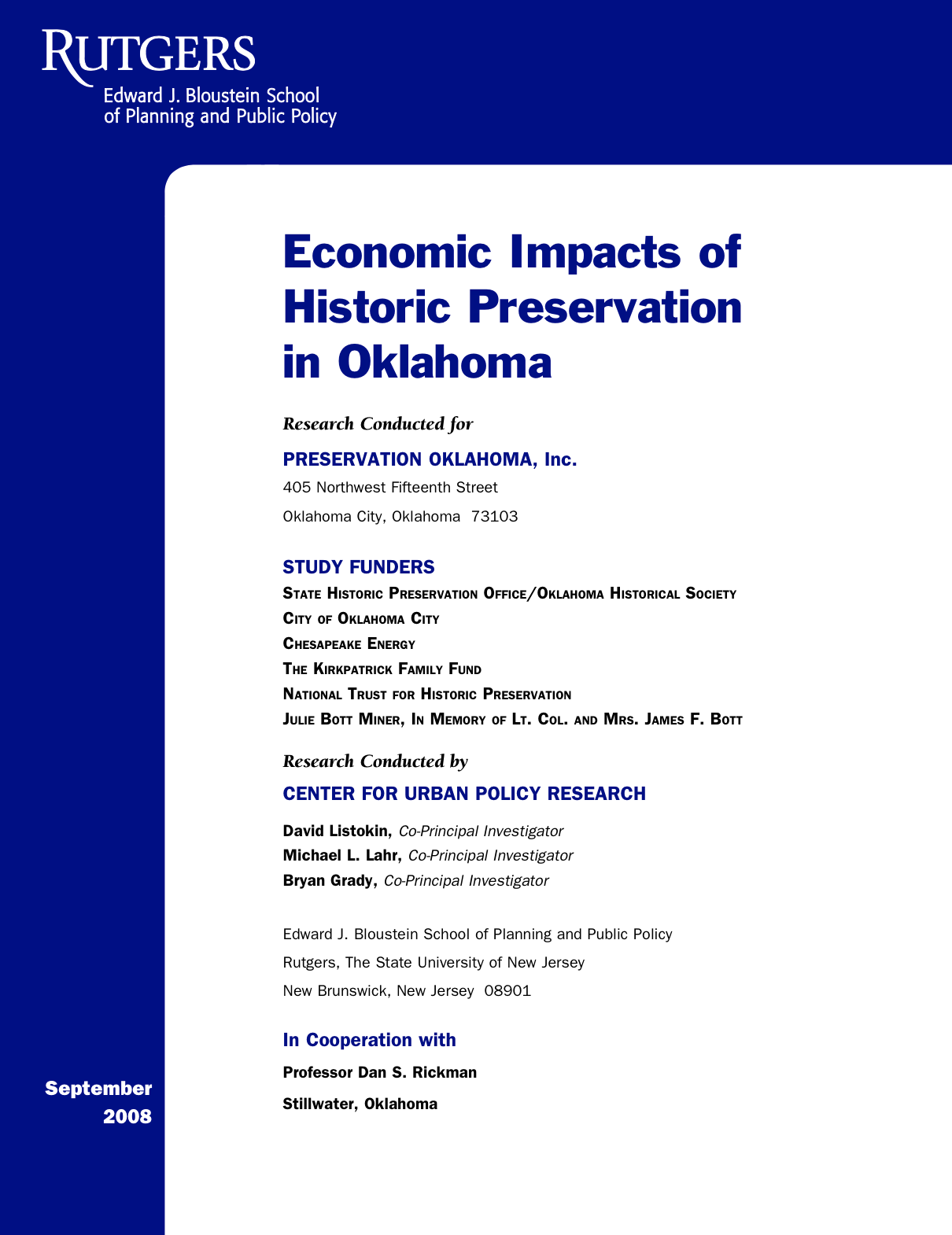This study examines the many significant economic effects of historic preservation in Oklahoma. The study examines the total economic effects of historic preservation, encompassing both the direct and multiplier effects. The direct impact component consists of labor and material purchases made specifically for the preservation activity. The multiplier effects incorporate what are referred to as indirect and induced economic consequences. The indirect impact component consists of spending on goods and services by industries that produce the items purchased for the historic preservation activity. The induced impact component focuses on the expenditures made by the households of workers involved either directly or indirectly with the activity. To illustrate, lumber purchased at a hardware store for historic rehabilitation is a direct impact. The purchases of the mill that produced the lumber are an indirect impact. The household expenditures of the workers at both the mill and the hardware store are induced impacts. Economists estimate direct, indirect, and induced effects using an input-output model (I-O). This study specifies the total economic effects of major elements of historic preservation in Oklahoma through a state-of the-art I-O model developed by the Center for Urban Policy Research (CUPR) for the National Park Service, Division of Cultural Resources, National Center for Preservation Technology and Training. The model is termed the Preservation Economic Impact Model (PEIM).
In the current analysis in Oklahoma, the PEIM is applied to both annual (2007) historic preservation investment in this state and to the cumulative investment of two major historic preservation subsidies/programs applied in Oklahoma. The PEIM is first applied to an annual (2007) outlay of major components of historic preservation investment. The annual Oklahoma historic preservation components considered by the PEIM include historic rehabilitation ($125 million in 2007), heritage tourism ($175 million in 2007), and the state’s Main Street program ($57 million 1 in 2007)—for a total of $357 million in 2007. The PEIM is then also applied to cumulative $1,392 million expenditures attributable to two major programs for historic preservation (i.e. over the life of the program being modeled expressed in current value—2007—terms) in Oklahoma: the federal historic rehabilitation investment tax credit (ITC) since its inception in 1978 through 2007 ($507 million) and the Main Street program since its inception in Oklahoma in 1986 through 2007 ($885 million). (The $507 million and $885 million are both expressed in inflation-adjusted dollars, taking into account inflation over time.) The results of the PEIM model include many fields of data. The fields most relevant to this study are the total impacts of the following:
- Jobs: Employment, both part- and full-time, by place of work, estimated using the typical job characteristics of each industry. (Manufacturing jobs, for example, tend to be full-time; in retail trade and real estate, part-time jobs predominate.) All jobs generated at businesses in the region are included, even though the associated labor income of in-commuters may be spent outside of the region. In this study, all results are for activities occurring within the time frame of one year. Thus, the job figures should be read as job-years, where several individuals might fill one job-year on any given project.
- Income: “Earned” or labor income, specifically wages, salaries, and proprietors’ income. Income does not include non-wage compensation (such as benefits, pensions, or insurance); transfer payments; or dividends, interest, or rents.
- Wealth: Value added — the sub-national equivalent of gross domestic product (GDP). At the state level, this is called gross state product (GSP) or, in some public data, GDP by state. Value added is widely accepted by economists as the best measure of economic well-being. It is estimated from state-level data by industry. For a firm, value added is the difference between the value of goods and services produced and the value of goods and non-labor
services purchased. For an industry, therefore, it is composed of labor income (net of taxes); taxes; non-wage labor compensation; profit (other than proprietors’ income); capital consumption allowances; and net interest, dividends, and rents received. - Output: Of the measures in any input-output report, perhaps the least well-defined one is that labeled “output.” Output is defined as the value of shipments, which is reported in the Economic Census. The value of shipments is very closely related to the notion of business revenues. Thus it is NOT the “output” to which most other economists refer and which is better known as “gross domestic product” (GDP). Within input-output analysis, “output” is also not the same as business revenues, for several reasons. It is probably better defined as net business receipts, however. First, establishments often sell some of their output to themselves and therefore do not ship it. Hence, such sales cannot be included in the Census’s tally of the value of shipments. Second, to avoid some double counting in national accounts (those used to produce input-output tables), “output” in the wholesale and retail trade industries is measured simply as their margins, which is value added plus the costs of inputs used in the course of doing business. That is, for these trade industries, “output” does NOT include the value of the items stocked on shelves.
- Taxes: Tax revenues generated by the activity. The tax revenues are detailed for the federal, state, and local levels of government. Totals are calculated by industry. Federal tax revenues include corporate and personal income, Social Security, and excise taxes, estimated from calculations of value added and income generated. State tax revenues include income, excise, sales, and other state taxes, estimated from calculations of value added and income generated (e.g. visitor purchases). Local tax revenues include payments to sub-state governments, mainly through property taxes on new worker households and businesses. Local tax revenues can also include sales and other taxes.
